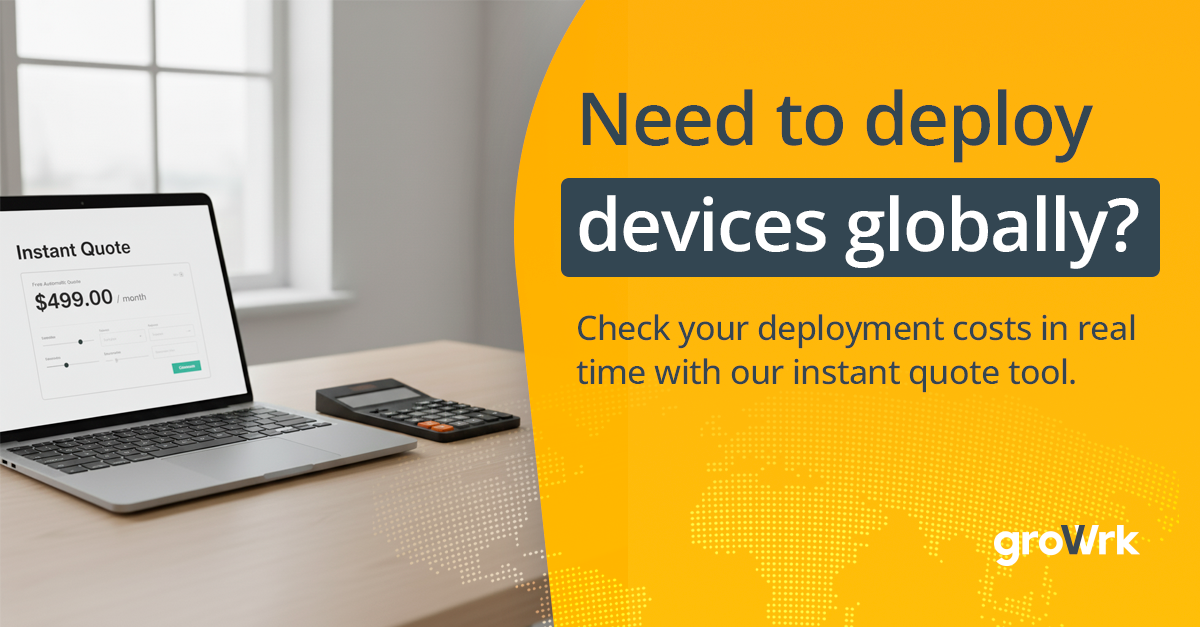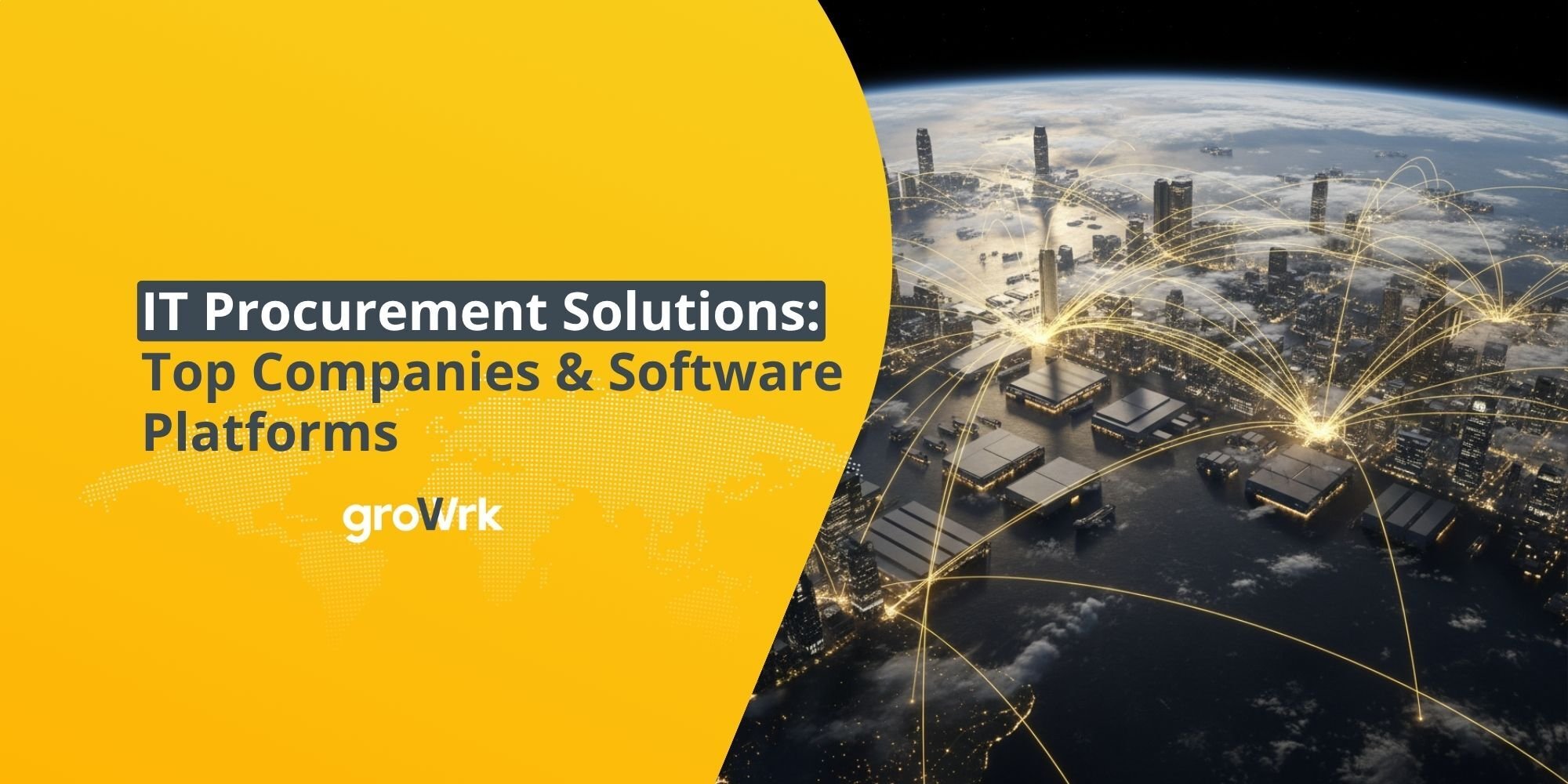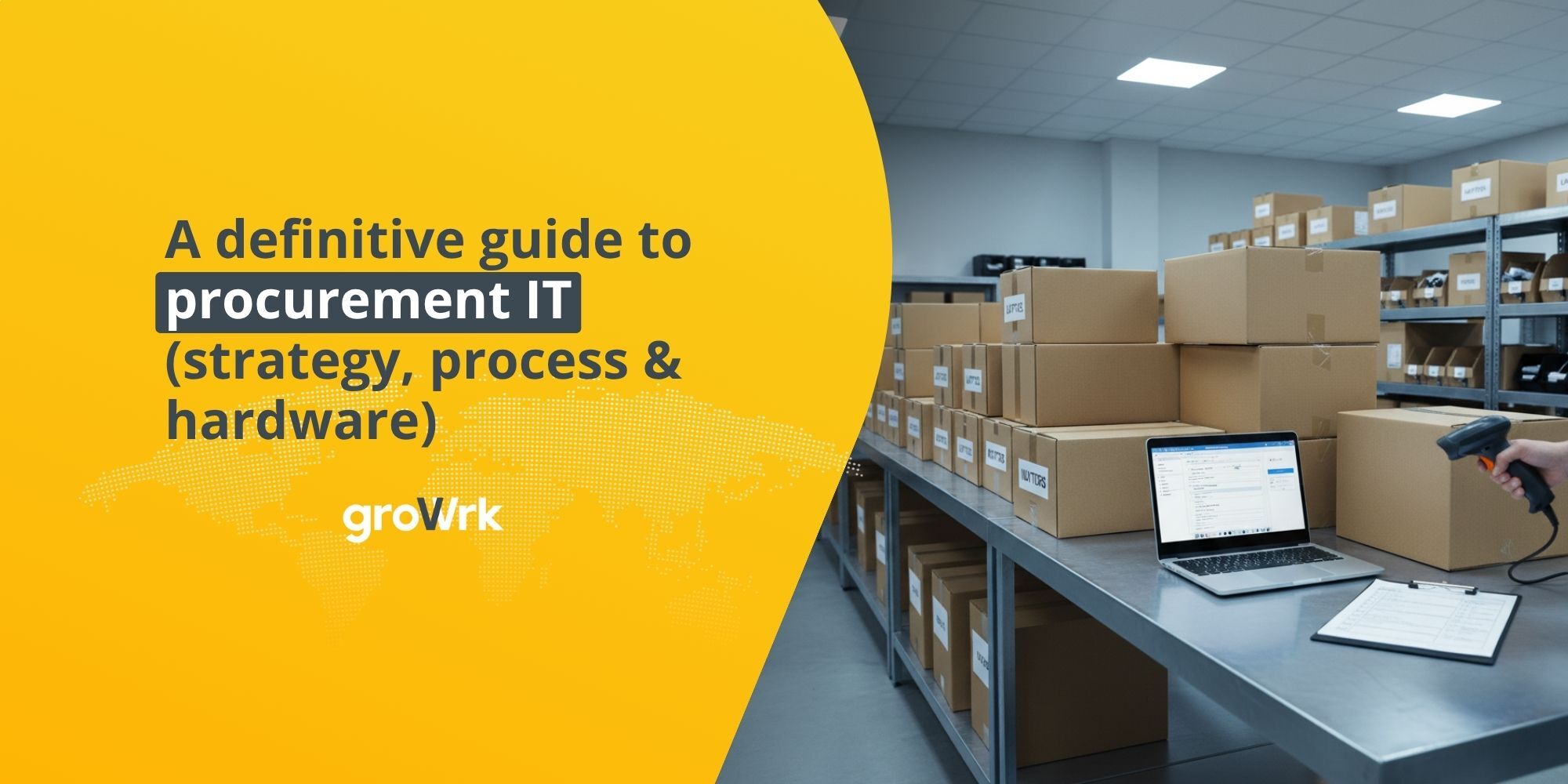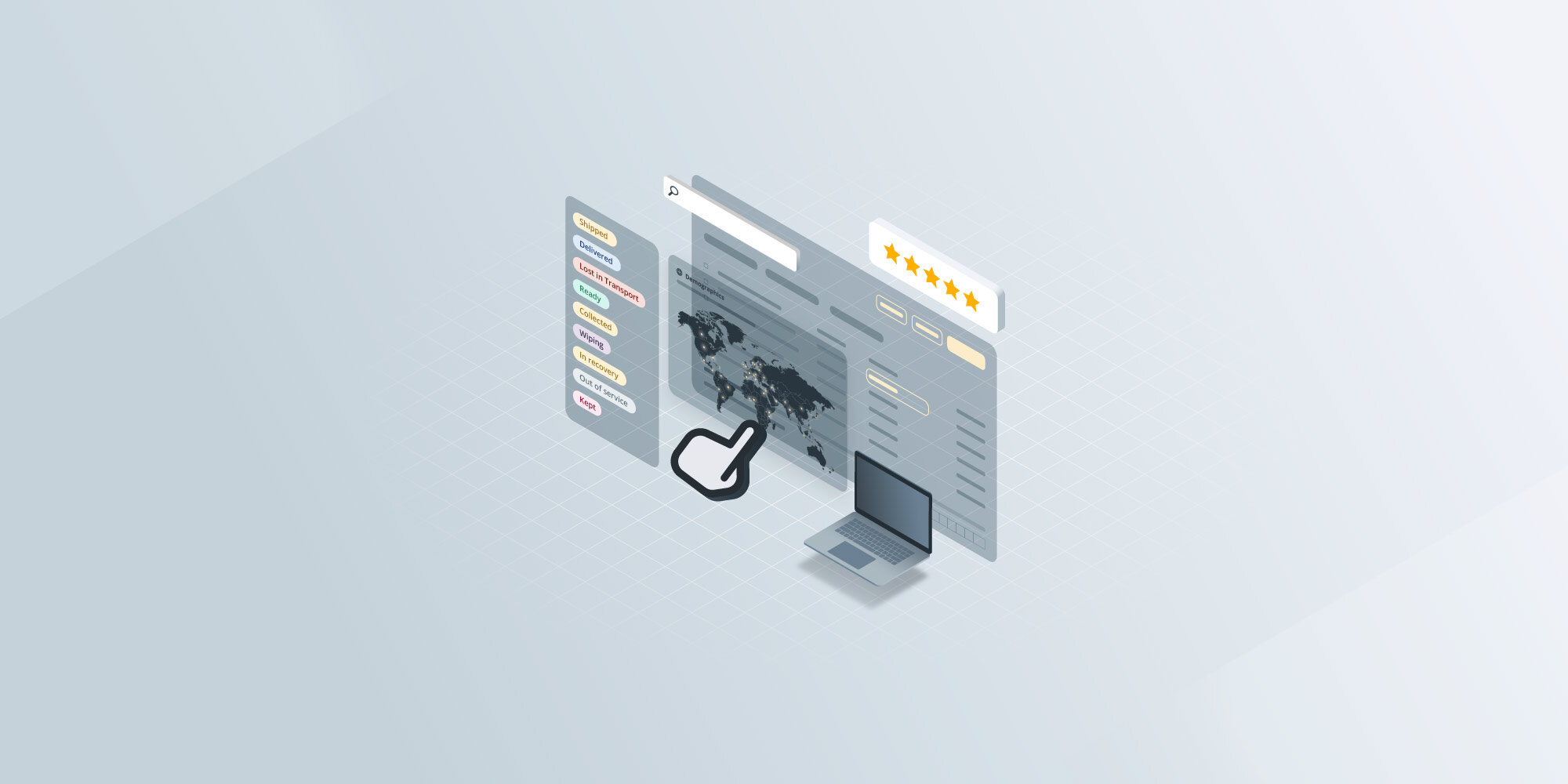The Definitive IT Procurement Guide (strategy, process & hardware)
 Mara Quintanilla
Mara Quintanilla
Many organizations rely on procurement software and hardware procurement systems for daily business operations. But did you know that companies in the U.S. and Canada waste over 1.5 billion dollars and 32 million man-hours on inefficient procurement processes?
IT procurement strategy involves sourcing and acquiring IT hardware assets while considering a company’s business needs and budget. However, CPOs, COOs, CTOs, IT managers, and procurement managers face the challenge of meeting different departments' requests, managing budgets, or finding the right vendors and products.
In this comprehensive guide to IT procurement, we'll cover what is IT procurement, its importance, a breakdown of the IT procurement process steps, challenges, IT procurement best practices, and how to find the right IT procurement strategy for global teams.
Want to see how easy it is to procure equipment with the GroWrk platform? Check out this product demo below!
What is IT procurement?
IT procurement involves acquiring technology-related products, services, and solutions that align with an organization's goals. It involves identifying needs, evaluating vendors, and selecting hardware, software, and services that enhance operational efficiency.
Effective technology procurement focuses on evaluating vendor reputation, cost analysis beyond the purchase price, integration with existing systems, scalability, and flexibility. Managing risks, fostering vendor relationships, and ensuring future relevance through innovation are also essential in creating a solid procurement strategy.
For procurement managers, a successful IT procurement strategy depends on measuring performance, quantifying ROI, and keeping track of industry trends. A well-executed process can also reduce costs and improve implementation, ensuring the organization remains competitive and achieves sustainable growth.
IT Procurement Categories
IT procurement categories encompass the various types of technology products and services that organizations acquire to support their business operations. Understanding these categories helps streamline the procurement process and ensures that all technological needs are met efficiently.
These categories can include:
- Hardware such as computers, servers, and networking equipment
- Software solutions ranging from operating systems to specialized applications
- Services like cloud computing, cybersecurity, and IT consulting.
Why IT procurement is important and why IT and procurement should work together
As companies turn to digitalization to manage their sourcing, procurement, payment, and purchasing tasks, procurement as a service is becoming more popular globally. In 2022, the size of the worldwide procurement as a service market reached USD 6.15 billion, and it is projected to grow by 11.1% from 2023 to 2030, according to Grand View Research.
IT procurement differs from regular purchasing because it involves assessing company requirements, managing vendors, and negotiating contracts.

In an era where cloud-hosted and subscription-based software abound, departments often independently adopt solutions without consulting IT. This can lead to shadow IT–using software the IT team doesn’t know about–jeopardizing security and missing out on integrations between software tools.
While planning your IT procurement strategy, doing market research and carefully selecting vendors helps organizations optimize their technology investments, mitigate risks, and align their technology infrastructure with strategic objectives.
Prevent Shadow IT
Shadow IT refers to the use of technology products and services within an organization without the knowledge or approval of the IT department. This practice can lead to significant security risks, data silos, and inefficiencies. To prevent shadow IT, organizations should implement the following strategies:
Prevent Redundancies in Your Tech Stack
Redundancies in the tech stack occur when multiple technology products or services perform the same or similar functions. This can lead to inefficiencies and increased costs. To prevent redundancies, organizations should take the following steps:
Easily Monitor Tech Usage
Monitoring tech usage is crucial for ensuring that technology products and services are used efficiently and effectively. Here are some methods to easily monitor tech usage:
The ideal IT procurement management process in 9 steps
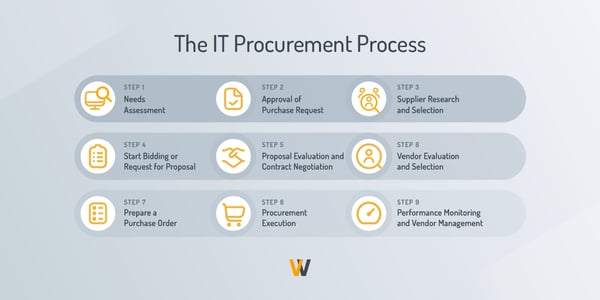
An efficient IT procurement process entails a structured approach that aligns technology acquisition with business goals. This 9-step IT procurement process will guide you through the entire procurement project, from assessing needs to monitoring performance.
1. Needs assessment
A successful IT procurement process project will start by assessing and identifying your organization's specific IT requirements. This involves an in-depth review of your current tech stack to identify gaps or areas that require improvement.
In this initial step, teams can select tools that will enhance their efficiency and productivity or that will automate tasks by integrating with existing systems.
2. Approval of purchase request
After identifying company requirements, the procurement team will have to justify those specific purchase requests. The previous needs assessment step will make this easier, as procurement managers will know why each team needs certain tools.
Before purchase requests are approved, relevant stakeholders will evaluate the benefits and risks of each tool to ensure alignment with organizational goals and cost-effectiveness.
3. Supplier research
In this part of the IT procurement process, companies must decide whether to make the solution in-house or procure it externally. A make-or-buy analysis can help evaluate the advantages and drawbacks of purchasing an existing platform versus developing a custom one with your team.
If you buy a solution from an external source, you must conduct market research to identify potential vendors and evaluate their offerings against your requirements. After that, you need to create a shortlist of those who can meet your technical needs.
4. Start bidding or Request for Proposal (RFP)
Once you’ve identified potential suppliers, you will need to issue a comprehensive Request for Proposal (RFP). This document describes the project announcement and solicits bids from contractors to complete it. The RFP will serve as a blueprint for potential suppliers to understand the project's requirements, expectations, and timelines.
5. Proposal evaluation and contract negotiation
At this point in the IT procurement processes, procurement managers will analyze the responses you get from suppliers using your predefined evaluation criteria. This step helps you to gauge their suitability against your organization's requirements. Once you have evaluated their answers, it's time to negotiate terms with them.
Negotiation is crucial to ensure an agreement that meets the needs of both parties. By doing so, you can establish a good relationship with your suppliers, which is essential for the long-term success of your organization.
6. Vendor selection
Once you have identified the ideal supplier, it's recommended to formalize your selection through IT procurement contracts and effective vendor management. These contracts should specify all important details regarding the product or service to be acquired, ensuring that both parties are fully aware of the terms and conditions of the agreement. Effective contract management helps ensure compliance with terms and mitigates risks related to delivery, quality, and support expectations.
7. Prepare a purchase order
After carefully choosing a suitable supplier and signing the contract, you must draft a purchase order. This document should clearly outline the acquisition's pricing, specifications, and terms and serve as a formal agreement between both parties. By doing so, you can ensure that the transaction is solidified and that all expectations are set precisely, thereby promoting a more streamlined and successful business relationship.
8. Procurement execution
Upon delivering the purchase order, the supplier acknowledges receipt and proceeds to provide the product or service. You must check the quality of the product after receiving it and finalize payment afterward.
9. Performance monitoring and vendor management
After implementation, you will need to establish a set of metrics that can help track the performance of IT software's performance and its impact on internal operations. This data-backed approach enables more accurate Return on Investment (ROI) measurement for future procurement decisions.
By carefully monitoring and analyzing performance, you can gain valuable insights into its effectiveness and identify areas where improvements can be made. Ultimately, this will enable your organization to make more informed decisions regarding the deployment and use of its IT assets and ensure that you are maximizing the value of your technology investments.
What is the right IT procurement strategy for global teams?
%201.02.16%20a.%20m..png?width=800&height=412&name=Captura%20de%20pantalla%202024-04-17%20a%20la(s)%201.02.16%20a.%20m..png)
Embrace cloud-based solutions
Adopting cloud-based IT procurement solutions is a must for global teams. These platforms offer the advantage of consolidating the IT procurement process into a centralized location. By doing so, they streamline workflows, automate approval processes, and enhance visibility across dispersed teams.
Automation expedites requisition and approval procedures and fosters real-time collaboration among team members, regardless of their geographical locations. This centralized approach minimizes manual intervention, reduces errors, and ensures greater process efficiency.
A cloud-based solution like GroWrk can streamline your organization's entire procurement process. We procure and manage IT equipment in more than 150 countries so your IT team can easily provide equipment for remote workers in a distributed world.
Find one central vendor for IT hardware procurement
When it comes to global IT procurement strategy, it's essential to centralize vendor relationships, especially for IT hardware needs. This approach can simplify the process while maintaining a professional standard.
Using a platform like GroWrk provides a singular marketplace where companies can acquire all the hardware they need anywhere in the world. Our centralized marketplace solution minimizes the complexity of managing multiple vendor relationships, simplifies the selection process, and ensures standardized quality and pricing. Moreover, it eliminates the logistical challenges associated with global procurement.
Prioritize compliance with regional regulations
Global IT procurement strategy requires close attention to regulatory compliance in each region where you operate. Different countries have unique import, export, data protection, and labor laws that can impact equipment procurement, shipping, and usage. Optimizing the process to ensure compliance helps organizations avoid costly fines, delivery delays, and potential legal complications.
Working with a provider like GroWrk can simplify compliance. We handle regional regulations across over 150 countries, ensuring your IT equipment meets local standards and is delivered smoothly.
Leverage data analytics to understand the ROI of solutions
Incorporating data analytics into global IT procurement strategy can yield significant benefits. Understanding the ROI of chosen solutions is particularly important for teams across different locations.
Leveraging data analytics allows organizations to make informed decisions based on actual business figures. It can help shed light on delivery times, onboarding speed, and potential savings on international deliveries.
By analyzing data-driven metrics, organizations can optimize procurement decisions, improve resource allocation, and ensure the effectiveness of chosen solutions across global operations.
Implement robust IT asset management
For distributed teams, tracking and managing devices through a streamlined IT asset management process is critical to maintaining operational efficiency and security. Effective asset management includes lifecycle tracking, warranty management, and regular audits to monitor asset health and usage.
Plan for scalability and adaptability
A successful IT procurement strategy must be flexible enough to scale with organizational growth and adapt to changing business needs. Global teams often need rapid deployment of IT assets, so working with a provider that can scale operations is essential.
GroWrk's extensive supplier network and scalable services enable businesses to adjust IT resources quickly, whether they are onboarding a large team or expanding to a new region. Our adaptable solutions make it easy to add or reallocate equipment, allowing your IT procurement strategy to keep pace with your evolving workforce.
Focus on end-to-end support for distributed teams
Supporting distributed teams means going beyond procurement to cover the entire IT procurement process, including deployment, setup, and ongoing technical support. This ensures employees have a seamless experience, regardless of their location.
With GroWrk, companies benefit from end-to-end support, from delivery and setup to asset management and troubleshooting. Our comprehensive support model empowers IT teams to manage distributed infrastructure without local technical resources, enhancing efficiency and employee satisfaction.
Get an instant quote
Common challenges in IT procurement
IT procurement doesn't come without challenges. Some common challenges include:
- Lack of clarity on technology: Organizations often struggle to fully understand the rapidly evolving landscape of technology, which can lead to confusion about what solutions best fit their needs. This lack of clarity can result in poor decision-making and the acquisition of technology that does not align with business objectives.
- Difficulty of selecting the right vendor: With a multitude of vendors offering similar products and services, choosing the right one can be daunting. Organizations must evaluate vendors based on criteria such as reliability, reputation, cost, and the ability to meet specific technological requirements, which can be a complex and time-consuming process.
- Controlling costs: Managing expenses in IT procurement process is a significant challenge, as costs can quickly escalate due to unforeseen expenses, such as maintenance, upgrades, and training. Organizations must implement effective budgeting and cost-control measures to ensure that procurement remains within financial constraints.
- Ensuring data security and privacy: As organizations procure IT procurement strategy, they must prioritize data security and privacy. This involves ensuring that vendors comply with security standards and that the technology acquired does not expose the organization to data breaches or privacy violations.
- Integrating new systems with existing infrastructure: Introducing new technology into an existing IT environment can be challenging, as it requires seamless integration with current systems. Organizations must ensure compatibility and interoperability to avoid disruptions and maximize the benefits of new technology.
However, organizations can navigate IT procurement process with greater efficiency by using procurement software. Additionally, being aware of these hurdles and developing strategies will make it easier to overcome them.
Deep dive: Mastering IT hardware procurement
Hardware procurement impacts business operations by influencing scalability, security, and efficiency. Growrk advocates informed decision-making and standardization.
Key considerations when buying hardware
When buying new hardware, you should consider several factors that determine performance, life cycle and value:
-
Compatibility: Ensure devices do not interrupt current systems and can integrate seamlessly with your organization’s existing systems.
-
Scalability: Choose hardware that allows for future growth.
-
Security & Compliance: Validate encryption, secure boot, and regulatory compliance.
-
Total Cost of Ownership (TCO): Purchase price, support, software, energy, and disposal to be considered.
Example TCO calculation for a laptop:
|
Item |
Cost (USD) |
|
Purchase price |
1200 |
|
Warranty and support |
200 |
|
Software licensing |
150 |
|
Energy and maintenance |
50 |
|
End-of-life disposal |
100 |
|
Total TCO |
1700 |
Developing a hardware standardization policy
-
Define standards per device category.
-
Reduce support complexity and redundancies.
-
Simplify procurement and inventory management.
-
Streamline vendor negotiations through repeatable orders.
The big decision: New vs. refurbished vs. leasing
|
Option |
Pros |
Cons |
|
New |
Latest technology, warranty, and long lifespan |
High upfront cost |
|
Refurbished |
Cost-effective, eco-friendly |
Limited warranty, older tech |
|
Leasing |
Lower initial cost, flexible upgrades |
Long-term cost may be higher, with less control |
IT procurement best practices

Clearly define requirements and prioritize integrations
As we've mentioned before, IT procurement best practices go beyond monetary transactions. They are a process that entails needs assessment, market research, negotiating contracts, and more.
For an effective IT procurement process, you can begin by meticulously outlining your requirements for the desired solution. This means identifying essential features, scalability, cost considerations, and compatibility with existing systems.
Also, consider integrations while you establish your company's IT requirements. Seamless integration with your existing tool and current technology ecosystem can maximize your operational efficiency. Check out our list for procurement best practices below:
Research vendors thoroughly
Thorough vendor research is paramount when procuring IT products. Explore options that align with your specific company needs. You then have to prioritize those supplier relationships and focus on maintaining their speed and cost in fulfilling orders For instance, vendors like GroWrk, can provide enhanced flexibility and accessibility. Seamlessly procuring IT equipment anywhere in the world fosters efficient acquisition and deployment.
Foster cross-functional collaboration
Collaboration between different departments within a company is crucial for the IT procurement process. While the IT department plays a significant role in maintaining the technical infrastructure, it's equally important to understand the hiring goals and onboarding procedures of HR. This way, the chosen solution can cater to everyone's needs, ensuring a smooth and efficient onboarding.
Consider Total Cost of Ownership (TCO)
When deciding on purchasing any product or service, it is crucial to consider the Total Cost of Ownership (TCO) beyond the upfront costs. TCO encompasses all expenses you may incur during and after implementation, including maintenance, training, and potential upgrades. By evaluating TCO, you can gain a comprehensive financial perspective to help you make informed decisions that align with your budget and business goals.
Stay up to date on the latest IT procurement trends
Staying up-to-date with technology trends will ensure your business remains competitive. Embracing innovations like Artificial Intelligence (AI), Robotic Process Automation (RPA), and the shift from on-premise to distributed solutions will help your organization stay ahead of the curve. Keep track of evolving supply networks so your IT procurement strategies remain forward-looking and agile.
Why companies choose GroWrk’s IT procurement services
At GroWrk, we understand that modern businesses need more than just a vendor to help them manage their technology needs. That’s why we offer end-to-end IT asset management services that go beyond standard purchasing and provide full IT procurement.

Our team of experts brings a wealth of knowledge and experience to the table, ensuring that we understand your business requirements and deliver tailored technology solutions. With our extensive network of trusted vendors, we ensure IT procurement best practices by helping you select the right partners and negotiating favorable contracts. Our cost-effective solutions reduce overall procurement costs without compromising on quality.
In a fast-paced business environment, partnering with GroWrk for IT procurement gives companies the expertise, resources, and experience to drive success. Request a demo today to learn how we can assist your business needs and make the IT procurement process more efficient, effective, and streamlined.
FAQs
What is the difference between procurement and purchasing?
Purchasing is primarily the act of acquiring goods or services through transactions. In contrast, procurement encompasses a broader scope. It entails identifying an organization's requirements, selecting suitable suppliers, negotiating payment terms, and fostering those supplier relationships in the long run.
How is IT procurement different from normal procurement?
IT procurement focuses specifically on acquiring information technology-related goods and services. Unlike traditional procurement, it involves assessing technological compatibility, ensuring data security, and aligning IT solutions with the organization's strategic goals.
What is the role of IT procurement?
IT procurement's role is strategically managing the acquisition of technology assets and services. This involves identifying technology needs, selecting reliable suppliers, negotiating contracts, ensuring cost-effectiveness, and overseeing the implementation and performance of IT solutions.
What is an IT procurement plan?
An IT procurement plan outlines the organization's approach to acquiring technology assets and services. The IT procurement team identifies your business needs, defines procurement objectives, selects suppliers, determines budget allocation, and establishes a timeline for procurement activities, among other tasks.
What are common jobs in IT procurement?
Procurement professionals can have many roles inside an organization. Typical roles in this area include IT Procurement Specialist, Procurement Manager, General Procurement, Procurement Operations Specialist, or E-Procurement Specialist. These roles collectively contribute to a well-orchestrated IT procurement process that supports the organization's technological needs and business objectives.
Why is a holistic procurement strategy important?
A holistic procurement strategy is vital because it aligns your procurement activities with your business goals, driving overall success. By doing so, it ensures that every purchase you make supports the strategic objectives of your organization, helping you grow and thrive!
How does digital procurement improve efficiency?
Digital procurement significantly boosts efficiency by automating tasks, minimizing errors, and providing clear data visibility for better decision-making. Embrace technology to streamline your procurement process and watch your productivity soar!
What is the Total Cost of Ownership (TCO)?
Understanding Total Cost of Ownership (TCO) empowers you to make smarter purchasing decisions by considering all expenses associated with a product throughout its entire lifecycle. This holistic view ensures you can budget effectively and maximize your investment!
Why are strong supplier relationships important?
Strong supplier relationships are crucial because they lead to cost savings, enhanced product quality, and a more reliable supply chain. By fostering effective communication and continuous improvements, you set the stage for success!



